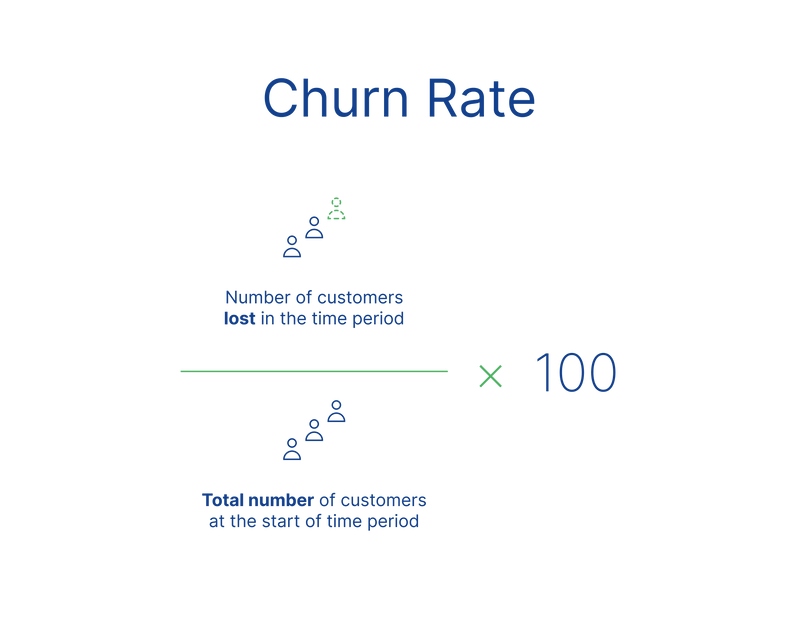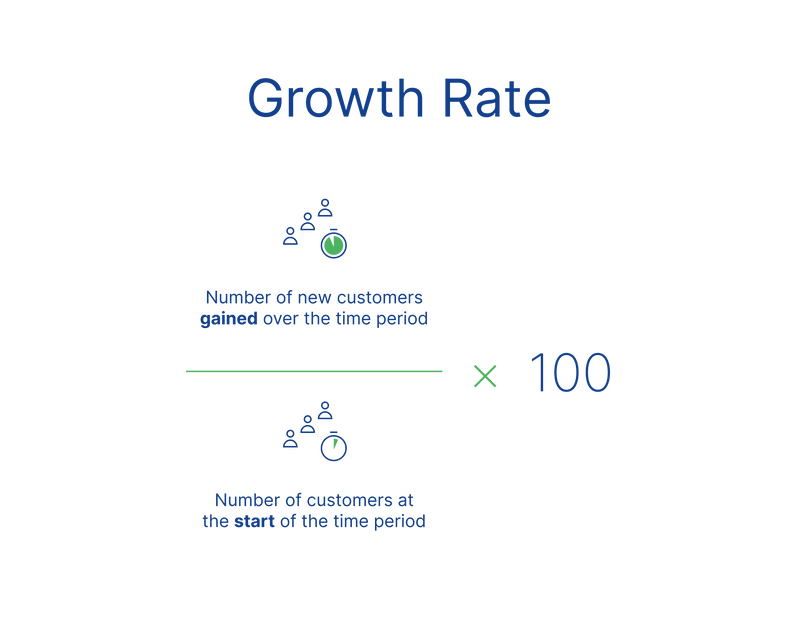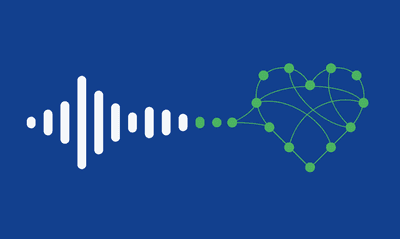What Is Customer Churn, and How You Can Calculate It?
In order to create long-term sustainable growth, you need to understand any retention issues that your business may have; therefore, one of the most important metrics to track is your customer churn rate. In this blog post, we will look at how to calculate customer churn and what steps you can take to reduce it.
9 min read

Tatiana Ogurtsovskaia
Jun 22, 2021

Not only does acquiring customers cost five times more than retaining existing ones, but if you increase your customer retention by just 5%, you can increase your business’s profitability by up to 75%. It is, therefore, evident that managing your customer churn is vital for profitability and growth; focusing on building long-term customer relationships is more cost-effective than creating campaigns to attract new customers.
Churn rate is a key indicator of the health of your business, playing a pivotal role in a business’s ability to forecast accurately and giving an indication of future expected revenue. Along with providing an indication of profitability, churn helps us to assess your customer service and retention strategies. Tracking churn can help you to identify fluctuations early on, giving you time to address the problems and re-strategize.
It is clear that reducing your churn metric has significant benefits for your business; however, before we look at strategies to lower customer churn, let’s first look at the definition of churn rate and how you can calculate it.
What Is Churn Rate?
Customer churn rate is the percentage of customers lost over a specific period of time. Churn can take many forms; it can be the cancellation of a subscription, lack of renewal on a contract, or customers who fail to make a repeat purchase. Churn rate only applies to paying customers, meaning those who have only signed up for a free trial should be excluded from your calculations.
Customer Churn Rate Formula
Churn looks at the number of customers that leave over a period of time; therefore, before you can calculate the churn rate, you need first to specify the period you are evaluating. Most businesses choose to look at churn over a monthly, quarterly, or yearly basis; however, for some, it could be over a shorter period, such as weekly or daily.

Example
Tony has a B2B SaaS company. Let’s say we want to measure the total customer churn at Tony’s over a quarterly period. At the beginning of the quarter, Tony had 50,000 customers; by the end of the quarter, Tony had lost 1,500 customers.
Churn Rate = (1,500/50,000) X 100 = 3%
Churn rates will vary for different sized companies and various industries, with B2B businesses often having a lower churn rate than B2C. While, initially, 3% might not seem like a significant turnover and within a good range of churn for a B2B company, if this figure increases over an annual period, it can end up seriously affecting a company’s bottom line.
Metrics to Track Along with Churn Rate
While customer churn rate is a vital metric, it will not give the whole picture; it will demonstrate that you are losing customers but not the reason why. Customer churn rate does not look at revenue or growth, which are two other critical indicators of the health of your business. Therefore, to get a broader view of your company’s health, you need to also look at your revenue churn rate and growth rate within the same time period.
What Is Revenue Churn Rate
In some cases, a company will choose to measure its churn rate in revenue as well as in customers. Evaluating the revenue churn rate will show whether your customers have dropped to a lower plan or if they are spending less money at your store than usual. Revenue churn rate demonstrates the impact of churn on your revenue, which is vital for understanding the financial health of your business.

Example:
At the beginning of the quarter for Tony’s B2B SaaS company, he had $100,000 revenue, at the end of the period, he had $92,000 revenue; therefore, he has lost $8,000
Churn Rate = ((100,000-92,000)/10,000) X 100 = 8%
While Tony only lost 3% of his subscribers, most of them were subscribed to a premium plan; therefore, his revenue churn is 8%.
What Is Growth Rate
When looking at customer churn, to get a holistic understanding of the health of our business, you should also factor in growth rate. Customer growth rate looks at how much or little our customer numbers are growing. If your customer’s growth rate is greater than your customer churn rate, your company is still growing; if it is lower, it means that you are losing overall company growth.

Example
Tony had 50,000 customers at the start of the quarter; he has gained 3,000 new customers over that period of time.
Growth Rate = (3,000/50,000) X100 = 6%
Often new businesses or those who are expanding will lose customers at a higher rate than older customers. This means that the customer churn rate does not always reflect the actual performance of your business. For this reason, it is always important to utilize a number of different metrics as this can give you an accurate view of how many customers you are losing, why you are losing them, and the overall health of your business.
What Causes Customer Churn
The best way to manage customer churn is to understand why customers are choosing to leave your business. Once you have identified why your customers may choose to take their business elsewhere, you can develop a clear strategy to tackle it.
Here are five of the most common reasons for customer churn.
Lack of Customer Service
Lack of or poor customer service is one of the most common reasons for customer churn. With 59% of consumers saying they’ll walk away from a brand after several bad experiences and 32% of all customers would stop doing business with a brand they loved after one bad experience, it is evident that the customer experience plays a key role in customer loyalty.
Poor Onboarding Process
When a customer chooses to do business with your company, you need to provide a proper onboarding process to ensure that they feel confident using your product or service. Your onboarding process could be a welcome email, phone call, product tutorial, online demonstrating, or a combination of all of them. Often, a poor onboarding process can leave customers confused and overwhelmed with the technology or under-whelmed with the service, resulting in them abandoning the product or service for a competitor.
Lack of Perceived Value
Effective pricing will play a key role in customer retention as customers need to feel like they are getting value for money. If your product is too expensive, they are likely to swap to a better-priced competitor. Whereas, if it is too cheap, they may lose trust in your ability to solve the problem or feel like they are getting a lesser service.
Poor Market Fit
One of the best ways to improve customer retention is to target prospects who will benefit from your product or service. If you are targeting and onboarding customers who are a poor market fit, you are wasting time, money, and resources on customers who are likely to churn. Along with implementing good qualifying practices, companies should constantly monitor their market to ensure that their product and service are developing with their customer’s changing needs. Companies need to be ever-evolving in order to remain ahead of the competition.
Involuntary Churn
Involuntary churn is issued with their payment, and therefore their account closes; this may be when a customer’s credit card expires, they are a victim of fraud, or there is an issue with the automatic payment. Involuntary churn is often overlooked in retention strategies and, therefore, ends up losing company’s a lot of great business.
How to Reduce Churn
Now that we understand what churn is and why it happens, we can start to look at how to reduce it. Here are five ways you can reduce customer churn.
Investigate the Reasons Your Customers Have Churned
The key to reducing churn is understanding why it has previously happened. The best way to do this is to contact churned customers through a survey, phone call, or email and ask them to give some honest feedback. Identifying the root of the cause will help you to develop strategies that are likely to help others stay.
Practice Proactive Communication
As one of the biggest reasons for customer churn being poor customer service, it makes sense that proactive customer service can keep customers engaged and happy. By nurturing and reaching out to your customers before they need to contact you, you demonstrate that you value their business and want to make sure that they get the most out of your product or service. Feedback shouldn’t only be for churned customers; by practicing proactive communication, you can also give your customers an opportunity to ask questions or air concerns, addressing any issues that could arise.
Optimize Your Onboarding Process
If a customer doesn’t understand how to use your product or service and there is not a straightforward onboarding process for them to learn from, they are likely to lose interest. To combat this, you should develop an onboarding process or customer roadmap that helps your customers navigate the product or service’s functionality, features, and process, with each product or service having its own tailored roadmap. Providing a solid roadmap will empower your customers, improve the customer experience and improve customer satisfaction.
Generate Customer Loyalty
Loyal customers are not only more likely to work with the company again and again, but they are also more likely to recommend you to colleagues, friends, and family. Customer loyalty can be generated by outstanding customer service, good communication, and also through offering them incentives. Incentives are perks, such as discounts, freebies, and promotions that give your customers a reason to keep coming back. A small renewal discount at their end of the contract can make your customers feel valued and be a big incentive for them to avoid going to a competitor.
Stay Competitive
The market is constantly changing, and to stay relevant, you need to continually improve and evolve. Businesses who are keeping an eye on the market and technological trends position themselves in a good market position, enabling them to adapt to the consumers changing needs. Ultimately, the success of your business depends on your customers’ satisfaction with your product or service, so keeping an eye on your competition will help you to stay relevant and avoid you being disrupted by the next big thing.
Conclusion
Churn is inevitable; however, if left unmonitored, it can significantly impact your bottom line. Assessing the churn metric is a key indicator of how your customers feel about your product or service and whether you are catering to their needs. When it comes to company growth, monitoring and lowering churn is an important piece of the puzzle. Even a slight reduction in churn can result in improving customer retention, increased revenue, higher referrals, increased upsell revenue, and longer customer lifetime value.


